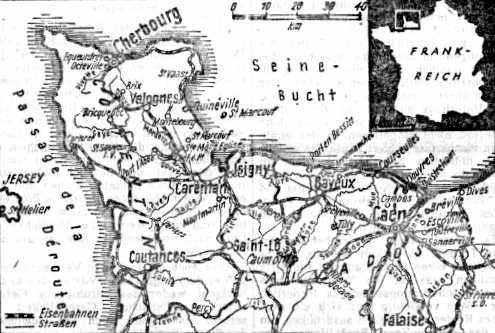The Free Lance-Star (June 22, 1944)
CONCERTED ATTACK MADE ON CHERBOURG
Port city rocked by violent land and air blows
Hard fighting goes on in city streets
SHAEF, England (AP) –
Gen. Dwight D. Eisenhower’s forces unlimbered this afternoon their greatest assault since the storming of the beaches of Normandy – a combined land and air attack intended to crack the last defenses of the fortified city of Cherbourg.
The attack began when waves of British and U.S. planes swept in with a terrific aerial barrage lasting 80 minutes, a field dispatch from Associated Press war correspondent Don Whitehead reported.
Rocked back on their heels by the weight of this assault in which light and medium bombers dropped down almost to cannon-mouth level to drop their explosive charges, the Germans were immediately beset by a thunderous artillery pounding which left smoke and flame sweeping the German forts.
U.S. doughboys of Lt. Gen. Omar N. Bradley, drawn up in position tensely waiting the effect of these blows, then swept forward. They were last reported hammering at Fort du Roule, only about 1,500 yards south of the military port, and at Fort Octeville, only slightly farther away to the southwest.
The latest headquarters announcements showed that the concentric attack had virtually split the German garrison into three segments.
Take road junction
Bradley’s troops captured Saint-Pierre-Église, eight and a half miles east of the port and the last road junction leading to Cherbourg from Cap Barfleur, isolating the Germans in the northeastern tip of the peninsula. Other troops coming up from the south had entered Quettehou, a large town near Saint-Vaast-la-Hougue on the east coast and 13 miles southeast of Cherbourg.
On the west, another spearhead had practically split the Germans in Cherbourg from those in the northwestern tip of the peninsula by advancing to within half a mile of Beaumont-Hague on the road to Cap de la Hague. Beaumont-Hague is eight and a half miles west of Cherbourg.
Supreme Headquarters said it lacked any knowledge of a reported American ultimatum by field radio to the Cherbourg garrison demanding surrender by 7:00 a.m. GMT today (3:00 a.m. EWT). The London Daily Sketch said last night it had recorded such a broadcast.
It was assumed that if the ultimatum was made, it was rejected and that Lt. Gen. Omar N. Bradley had ordered a final attack. Supreme Headquarters said it was possible the field commander might have made the demand on his own authority.
Find rocket bases
Allied experts flew into the Cherbourg Peninsula to investigate the flying bomb bases captured intact by U.S. troops, but the Supreme Command said there were no indications the Germans had been using them against England. It appeared, a spokesman said, that the American drive over the peninsula left the enemy insufficient time to get the launching sites ready for operation.
Except for the swift encircling drive on Cherbourg, there was little activity on the beachhead. The communiqué reported only patrol activity elsewhere, although enemy artillery and mortar fire in the British-Canadian sector at Tilly was said to be unusually heavy.
The Vichy radio this morning said warships offshore were supporting the Americans, but Supreme Headquarters said it had no knowledge of such a bombardment.
Destroying port
The Germans were still rushing to destroy everything in the port and city which could be of use to the Allies.
Reports here said that Cherbourg’s airfield appeared to be within the Allied grasp, if not already taken. This would be the first sizeable field captured in the beachhead drive and, when repaired, would permit the use of medium bombers.
Bad weather yesterday hampered air operations and also delayed unloading of war materials. A strong wind from the northeast whipped up a heavy surf on the beaches.
A dispatch last night from Associated Press war correspondent Don Whitehead quoted French civilians struggling through the lines as saying the Germans in Cherbourg had prepared for a street-by-street defense by knocking holes in the corner of buildings and setting up machine guns and anti-tank guns to cover the approaches.
